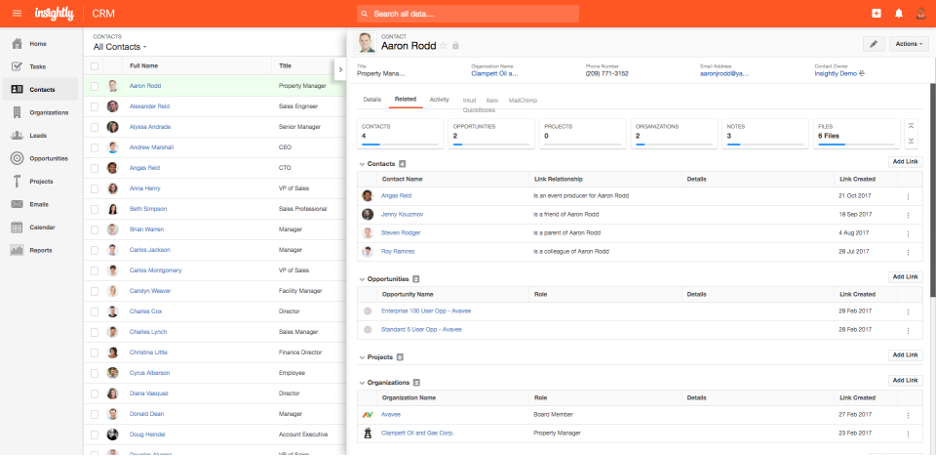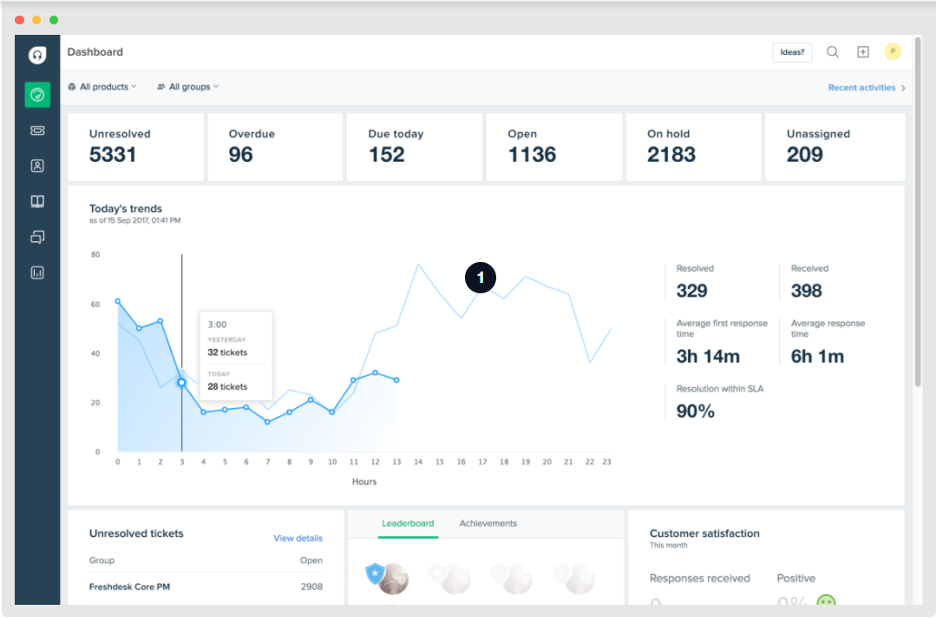Learn more about the four types of CRM software as well as their features and best use scenarios.
Customer relationship management, or CRM software, is key to fostering a customer-centric culture within your small business. It also makes it a lot easier for your customer service, marketing, and sales teams to perform their jobs effectively, resulting in higher customer satisfaction and customer retention.
How so? By putting customer data at your employees’ fingertips, among other features. A business that has a 360-degree view of its customers’ demographics, purchase history, and customer service interactions is going to have an easier time maintaining healthy customer relationships than a business that doesn’t have that information in one centralized location. CRM software also helps you track leads, send marketing emails, automate sales tasks, create custom reports, and much more.
So, if you’re looking to improve customer relations within your business, as well as use customer data to inform your marketing, sales, and customer service strategies, CRM technology is a must-have. We’ll walk you through the different types of CRM software, and what features to look for when shopping for a CRM system that best fits your needs.
How many types of CRM software are there?
CRM software can be categorized into the following four types:
Operational CRM improves your business’s operational efficiency through automation.
Strategic CRM focuses on customers and their interactions with your business.
Analytical CRM organizes and analyzes customer data with a focus on metrics, such as recurring revenue, top sales accounts, and customer retention rates.
Collaborative CRM focuses on sharing customer information among internal teams.
What to look for in CRM software
Calendar/reminder system
Set up reminders in customer accounts that sync with your calendar. These tasks can be anything from alerting a customer to the end of a trial period, or reminding a sales rep to follow up with a customer via phone.
Contact management
Store the contact information of customers and prospects, including their name, address, and contact number, in a centralized searchable database.
Email marketing
Manage mailing lists, monitor marketing campaign effectiveness, announce new product launches, and promote services.
Interaction tracking
Document customer conversations, track the activities of specific contacts, and add notes about client interactions.
Lead generation
Gather the contact information of a potential customer, such as their email address or phone number.
Lead qualification
Determine whether a customer or client is a good fit for your product or service based on their activity and interactions.
Marketing automation
Help your marketing team automate and manage marketing campaigns.
Pipeline management
Get a 360-degree view of your entire sales pipeline. Track which stage every lead is in and the number of leads you have in different stages, such as lead nurturing or closed deals.
Segmentation
Differentiate between a potential customer and an existing customer by grouping them into categories based on common traits in order to identify your target market.
Task management
Assign job responsibilities or tasks to members of your team and track their progress.
Territory management
Plan, map, and manage sales territories to generate leads and improve sales.
Workflow automation
Automate tasks such as sending marketing emails, scheduling follow-up events, and setting criteria for lead qualification.
Now that we’ve laid out some basic features and their capabilities, let’s dive deeper into each of the four types of CRM software, their defining features, and their best use scenarios.
1. Operational CRM
Operational CRM is all about streamlining customer relations operations within your organization. Whatever CRM processes your business is currently handling manually can be completed faster and more efficiently through operational CRM. One such process is organizing customer contact information, as shown in the screenshot below.

The contact management feature in Insightly CRM (Source)
Defining features
Operational CRM streamlines customer relationship processes for your business through features that highlight automation. Examples of these features include:
Calendar/reminder system syncing
Contact management
Marketing automation
Email marketing
Workflow automation
Automation features are useful not only for the time they save, but for giving different parts of your business more immediate access to customer information. For example, some CRM platforms allow you to automatically upload leads from different marketing channels. Those leads can be assigned to your sales team, who can then follow up with the information the lead needs in order to make a sale. In this case, operational CRM is beneficial in that it gets customers through your sales pipeline more quickly than if you were using manual processes.
Who should use it
If your business relies heavily on administrative processes to process client data, such as an accounting or law firm, operational CRM would be useful. Automating processes that are otherwise tedious and time consuming will allow your team to focus on more meaningful tasks, such as responding to clients. Operational CRM would also be a good fit if your business relies on information passing through multiple channels, such as in the sales example we just discussed.
Learn more about using technology to supercharge your law firm’s client management efforts in our blog post, 3 Legal Trends on the Rise (And How Your Firm Can Use Tech To Get Ahead).
2. Strategic CRM
Strategic CRM focuses on building strategies that are based on customer interaction. This type of CRM solution would be especially useful to your business if it thrives on long-term customer relationships. It’s called strategic CRM because it can help you build more effective business strategies through customer data and market trends, such as in the example shown below.

Freshworks’ CRM dashboard, which captures customer data in real time (Source)
Defining features
Strategic CRM prioritizes customer interactions through features such as:
Contact management
Interaction tracking
Lead generation and qualification
Pipeline management
Segmentation
These features provide you with customer insights that can help you adjust the way your team interacts with customers with the end goal of improving customer experience. One such insight might be whether your customers prefer to communicate with your team via email or social media.
Who should use it
If your business offers a service that’s meant to be recurring or ongoing, such as a gym, automobile repair shop, or internet service, strategic CRM can provide you with the tools to facilitate and support long-term relationships with your customers.
Make sure your team is equipped to handle any customer service curveball that’s thrown their way: Develop These 3 Customer Service Competencies to Supercharge Customer Satisfaction.
3. Analytical CRM
Analytical CRM helps businesses understand their customer data so that they can make better decisions. It focuses heavily on reporting analytics and provides details of metrics such as your average deal cycle, recurring revenue, top sales accounts, and customer retention rates.
Defining features
Analytical CRM monitors sales trends and gathers customer data through features such as:
Lead generation and qualification
Pipeline management
Territory management
These features can help your business recognize patterns in your customer data and offer a big-picture understanding of your business’s customer lifecycle: a process that encompasses customer identification, attraction, retention, and development. When you’re able to see where customers are exiting your sales pipeline, for example, you can use that information to troubleshoot your customer service strategy and walk through scenarios with your team.

The pipeline management feature in Salesforce CRM (Source)
Who should use it
If you’re looking to leverage customer data to improve your business’s sales and deliver more targeted marketing campaigns, you should opt for an analytical CRM platform. Analytical CRM would be useful to any business interested in these benefits.
Learn more about leveraging technology to lower customer churn in our blog post, How to Prioritize Customer Retention in Your Digital Strategy.
4. Collaborative CRM
Collaborative CRM is concerned with how multiple teams or departments within an organization can work together to provide better customer service. It’s most similar to strategic CRM in that the focus is on better serving customers, whereas operational CRM and analytical CRM are more focused on improving operations and sales, respectively.

Agile CRM’s video conferencing function (Source)
Defining features
Collaborative CRM relies on features that ensure that all team members are on the same page when it comes to customer interactions. These features include:
Contact management
Interaction tracking
Task management
Features that enable communication among teams are also common in collaborative CRM software, such as the video conferencing feature shown above from Agile CRM.
The features in collaborative CRM platforms allow departments such as sales, marketing, and customer support to work in harmony and exchange information more easily. When these departments work separately, or when customer data is siloed so that only certain teams have access to it, it’s more difficult to ensure that customers are adequately assisted across the board.
Who should use it
Businesses looking to improve collaboration between their internal teams, as well as external stakeholders, should opt for collaborative CRM software. It’s also great for businesses with multiple satellite locations or sister branches, such as credit unions, restaurant franchises, and healthcare clinics.
For more ideas on improving your team’s collaboration skills, check out How To Improve Team Performance in Your Small Business.
Want more information about CRM software?
While the categories we just discussed can help you better articulate the goals you’re looking to achieve from a CRM tool, it’s important to note that most customer relationship management systems will exist as some combination of these categories. Gaining clarity on which features are must-haves versus nice-to-haves for your business will make it a lot easier to find the best CRM software for you.

Screenshot comparing features from Salesforce, Hubspot CRM, and Insightly, taken by author
As shown in the image above, Capterra’s CRM software directory allows you to select up to four software vendors, and compare their features, pricing, integrations, and user reviews side-by-side before you make a purchasing decision. Be sure to check out our CRM Buyers Guide as well, and see who made our 2022 Shortlist.
Note: The applications mentioned in this article are examples to show a feature in context and are not intended as endorsements or recommendations. They have been obtained from sources believed to be reliable at the time of publication.
